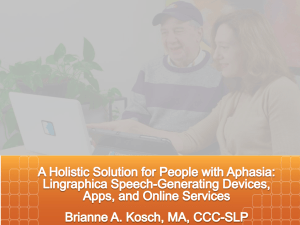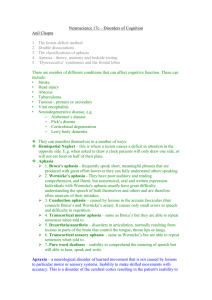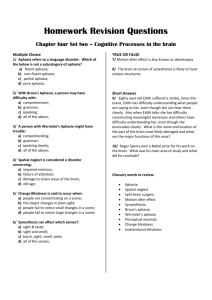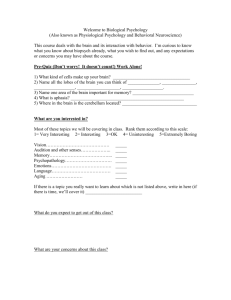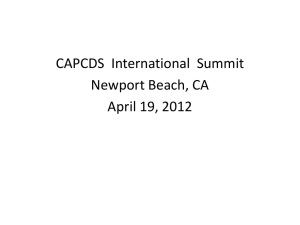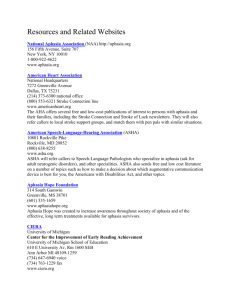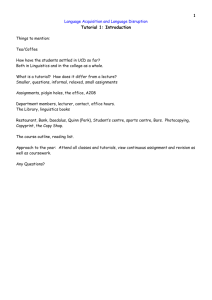Aphasia
advertisement
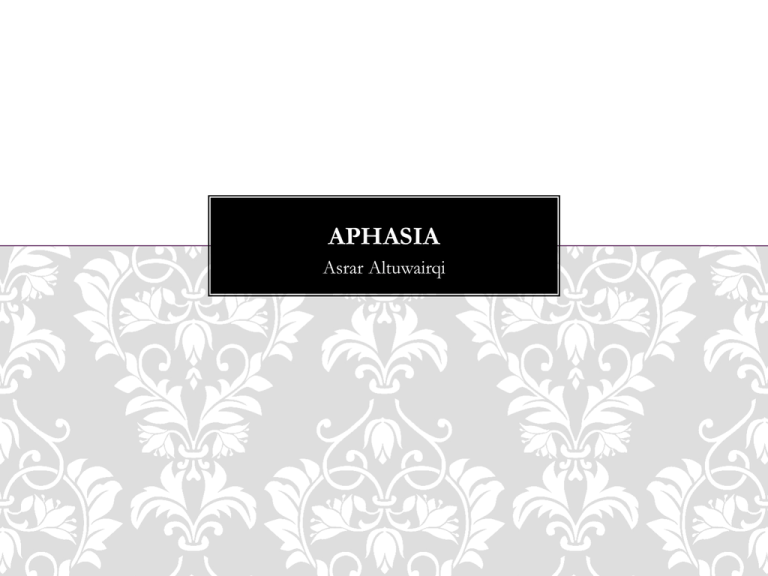
APHASIA Asrar Altuwairqi OUT LINE - What is Aphasia? Aphasia type What causes aphasia Sing and symptoms Fact about aphasia Aphasia assessment Aphasia management WHAT IS APHASIA - Acquired communication disorder results from damage to portions of the brain that are responsible for language (impairs a person's ability to process language). For most people, These areas are located in the left hemisphere. - The disorder impairs the expression and understanding of language as well as reading and writing APHASIA TYPE Syndrome Type Nonfluent Aphasia Characteristic Broc’s Agrammatism; effortful articulation of phrase length utterance; impaired prosody and intonation ; apraxia of speech; good comprehension Transcortical motor Little to no initiation of spontaneous speech; output similar to Broca’s but excellent imitation (even long utterances), relatively intact comprehension. Global Severe deficits in all area of language comprehension and production. TYPE OF APHASIA (CONT’) Syndrome Type Fluent Aphasia Characteristic Wernike’s Fluent but often meaningless speech (jargon); good articulation, intonation, and prosody; impaired comprehension. Conduction Relatively fluent speech; marked difficulty with imitation; good language comprehension Anomic Significant word-finding difficulties in the presence of otherwise fluent and grammatical speech; good comprehension APHASIA CAUSES Aphasia usually occurs suddenly, often as the result of a stroke or head injury, but it may also develop slowly, as in the case of a brain tumor, an infection, or dementia.. Aphasia may co-occur with speech disorders such as dysarthria or apraxia of speech, which also result from brain damage. SING AND SYMPTOMS • • • • • • inability to comprehend language inability to pronounce, not due to muscle paralysis or weakness inability to speak spontaneously inability to form words inability to name objects inability to repeat a phrase SING AND SYMPTOMS CONTINUE • • • • • • • • • paraphasia (substituting letters, syllables or words) agrammatism (inability to speak in a grammatically correct fashion) dysprosody (alterations in inflexion, stress, and rhythm) incomplete sentences inability to read inability to write limited verbal output difficulty in naming Speech disorder FACT ABOUT APHASIA • Anyone can acquire aphasia, including children, but most people who have aphasia are middle-aged or older. Men and women are equally affected. • Can a Person Have Aphasia Without Having a Physical Disability but many people with aphasia also have weakness or paralysis of their right leg and right arm. • The person's intelligence is basically intact APHASIA ASSESSMENT purposes of Language Assessment • Differential Diagnosis - It is necessary to determine whether a patient's language dysfunction is aphasia or something else. - Does the patient possess a speech or language impairment? - Is this impairment aphasia? - If the primary disorder is aphasia, what is its type and severity? ASSESSMENT COT’ • Determination of Level of Functional Communication - to provide a reasonable basis for the design and implementation of an individual treatment program. - What is the prognosis for recovery? ASSESSMENT (CONT’) Assessment area: 1- Spontaneous speech 2- Auditory Verbal Comprehension A. yes/no questions B. Auditory word recognition C. Sequential commands 3- Repetition 4- Naming A. Object naming B. Word fluency C. Sentence completion D. Responsive speech ASSESSMENT (CONT’) 5- Reading A. Reading - comprehension of sentences B. Reading - commands C. Written - word stimulus- object –choice matching D. Written – stimulus – picture – choice matching E. Picture stimulus –written word – choice matching F. Spoken words – written word - choice matching G. Letter discrimination H. Spelled word recognition I. Spelling ASSESSMENT (CONT’) 6- Writing A. Writing on request B. Written output C. Writing to dictation D. Writing dictated or visually presented words E. Alphabet and number F. Dictated letters and numbers G. copying of words of a sentence DEFERENTIAL DIAGNOSIS • Apraxia of speech is an oral motor speech disorder affecting an individual's ability to translate conscious speech plans into motor plans, which results in limited and difficult speech ability. it may cause difficulty: - Producing the desired speech sound. - Using the correct rhythm and rate of speaking. • Dysarthria is a motor speech disorder. The muscles of the mouth, face, and respiratory system may become weak, move slowly, or not move at all after a stroke or other brain injury APHASIA TREATMENT if the brain damage is mild, a person may recover language skills without treatment. However, most people undergo speech and language therapy to rehabilitate their language skills and supplement their communication experiences. Researchers are currently investigating the use of medications, alone or in combination with speech therapy, to help people with aphasia. Speech and language rehabilitation Recovery of language skills is usually a relatively slow process. Although most people make significant progress, few people regain full pre-injury communication levels. In aphasia, speech and language therapy: Starts early. Therapy is most effective when it begins soon after the brain injury. Builds on success. The speech-language pathologist uses exercises to improve and practice communication skills. These may begin with simpler tasks such as naming objects and evolve into more complex exercises of explaining the purpose of an object. TREATMENT CONT’ Shifts focus. The speech-language pathologist might teach the person ways to compensate for the language impairment and to communicate more effectively with gestures or drawings. Some people with aphasia may use a book or board with pictures and words to help them recall commonly used words or help them when they're stuck. Often works in groups. In a group setting, people with aphasia can try out their communication skills in a safe environment. Participants can practice initiating conversations, speaking in turn, clarifying misunderstandings and fixing conversations that have completely broken down. May include outings. Participating in real-life situations — such as going to a restaurant or a grocery store — puts rehabilitation efforts into practice. May include use of computers. Using computer-assisted therapy can be especially helpful for relearning verbs and word sounds (phonemes THANK YOU
